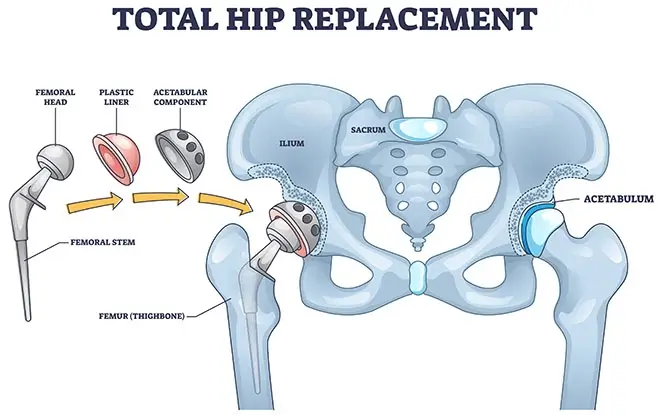A New, Minimally Invasive Hip Replacement Technique (Anterior Approach)

Anterior Hip Replacement Surgery
How Is Anterior Hip Replacement Done?
Anterior Hip Replacement Surgery vs. Posterior Hip Replacement Surgery
Considering a hip replacement surgery can be scary, after all, it is your central and core joint. Thankfully, recent advances in surgical techniques enable a minimally invasive approach that offers the benefits of faster recovery, reduced pain, and significantly less trauma.
Hip replacement surgery is one of the most performed orthopedic procedures around the globe. In Germany alone, approximately 200,000 hip replacements are performed every year and in terms of incidence, according to a study by market and consumer data firm Statista, Germany ranks first among European nations. Research suggests that increasing life expectancy as well as the prevalence of a growing older population, are the main reasons for the increasing patient numbers.
There is more than one surgical approach to replace a damaged hip joint. Traditionally orthopedic surgeons have used the posterior hip replacement approach.
However, more recently, the anterior approach is becoming increasingly popular. It is considered minimally invasive and promises quicker recovery and fewer complications compared to the posterior approach. It is also referred to as Muscle Sparing Hip Replacement Surgery.
A posterior approach is when your orthopedic surgeon replaces the hip through an incision on the backside of your thigh, while the anterior approach is when your surgeon replaces the damaged joint through an incision on the front side of your thigh.
The anterior hip replacement is more technically challenging and choosing an orthopedic surgeon experienced in this technique is crucial for a successful surgery.
What Is Hip Replacement Surgery?
A hip replacement procedure, also known as hip arthroplasty, is often performed to treat hip fractures or degenerative joint disease (osteoarthritis).
Hip replacement involves the insertion of a metallic or plastic joint prosthesis. It will allow you to walk again, reduce hip pain, and improve mobility.
Up until recently, almost all hip replacements were done using a posterior approach. With this approach, a six to 12-inch incision is made, cutting through the pelvic and buttock muscles to reach the hip joint, in order to replace the joint. The cutting of muscles generally necessitates certain precautions after surgery and can also cause functional weaknesses.
What Is Anterior Hip Replacement Surgery?
The anterior approach is a newer minimally invasive technique now being performed by some surgeons. This approach uses a smaller incision near the front of the hip and avoids muscle cutting to access and replace the joint. Although anterior hip replacement is considered minimally invasive, as mentioned, you’ll need to choose a surgeon with experience performing this technique to avoid any complications.

Who Is a Candidate for Anterior Hip Replacement?
If you have a damaged hip joint due to osteoarthritis or a femoral neck fracture, then you will probably need a hip replacement.
You will be considered for a minimally invasive anterior hip replacement if you meet the following criteria:
- You are not obese (or moderately overweight)
- Your pelvis is not too wide (determined during a physical exam)
- You don’t already have certain types of hip implants
The eligibility for minimally invasive hip replacement is determined in a case-by-case manner. You will be examined, and if you’re suitable for the procedure, you will be given the option.
How Is Anterior Hip Replacement Done?
Both the anterior and posterior hip replacement techniques involve removing the old damaged joint and replacing it with a round metallic or plastic hip prosthesis.
The hip prosthesis replaces the head of the femur (thigh bone). It has a ball-like shape that fits right into the hip socket, allowing your hip bone to move in a full range of motion. It reduces friction and improves mobility.
Anterior hip replacement is usually performed under general anesthesia. This means that you will be put to sleep and won’t feel anything during the surgery. In this method, the patient is placed in the supine position.
The total surgical time of anterior hip replacement is on average 2-3 hours. Since the anterior approach is much more technically demanding, it takes longer than the traditional approach which is usually performed in 1-2 hours.
Once you are asleep, a vertical 5-6 cm skin incision is performed on your upper thigh. The muscles and soft tissue are moved (not cut) to gain visual access to the hip joint. This key element makes the surgery minimally invasive - with minimal muscle cutting.
The old, damaged femur head is then cut and removed. The metallic or plastic prosthesis is attached atop the femur, and the joint is slid back into its socket.
The soft tissue and skin are then closed with sutures.
Benefits of Anterior Hip Replacement
The new anterior approach for hip surgery is slowly becoming more popular among surgeons as it has several benefits:
Less Invasive and Not as Traumatic
In the anterior approach, no major muscles are cut. The surgeon will move the muscles covering the hip joint and work around them. This also means that there is less blood loss. This is probably the top advantage of anterior hip replacement. It involves less trauma compared to the traditional posterior technique.
In a posterior approach, the gluteal (buttocks) muscles are detached from the bone and cut. This can lead to more pain and a longer recovery time.
Reduced Pain
Pain after hip replacement can deter some patients from getting a prosthesis. Since the anterior hip replacement technique is minimally invasive involving less soft tissue trauma, post-op pain is less.
Quicker Recovery
Recovery after hip replacement surgery can take several months. You will have to use a walker or cane for several weeks during recovery before you can walk on your own.
Researchers have found that patients who get anterior hip replacement can leave the hospital in as little as 4 days and can stop using a walker 1 to 3 weeks earlier than those who get a posterior hip replacement. In some cases patients can walk without crutches as early as the next day
Additionally because patients recover quicker, and can keep their pelvis in a horizontal position, there is not as much need to compensate with the upper body.
Moreover, anterior hip replacement requires less precautions and physical limitations postoperatively. This can be attributed to the less traumatic and less invasive nature of this new hip replacement technique.
Easier Second Surgery
A prosthetic hip joint is very durable, but it can sometimes fail. Approximately 1 in 10 people will need hip replacement revision after 10 years of their first surgery. Since the posterior approach involves muscle cutting and more trauma, it causes more fibrosis and soft tissue scarring which makes it more challenging to perform a second surgery.
The advantage of anterior hip replacement makes for a smoother second surgery if you ever need it as no major muscles are cut.
Orthopedic surgeons are always searching for the least traumatic way to treat a damaged hip. So far, research shows that anterior hip replacement might be the way to go. Less trauma, reduced pain and a faster recovery, without compromising the results.
Anterior vs Posterior Hip Replacement - Which Is Better for You?
This depends on who you ask. The anterior minimally invasive hip replacement is probably better as long as it's being performed by an experienced surgeon. A surgeon that has already done this procedure numerous times. With the highest incidence of hip replacement per capita globally, Germany is well-positioned in terms of experience, research, and advancements in this field.
The sooner you get back to walking and moving, the more your surgery is considered successful. Researchers have already established that anterior hip replacement is less traumatic and leads to faster recovery without compromising the results.
However, if you don’t meet the criteria for anterior hip replacement, then the surgery might not be for you. A posterior approach might be the better choice in such cases.
For info on the areas of expertise of the clinic for Children, Adolescents, and Neuro-orthopedics at Rummelsberg Hospital, visit this page.
For more details on the team at the Children, Adolescents, and Neuro-orthopedics clinic at Rummelsberg Hospital, click here.

Prof. Dr. med. Wolf Drescher is a specialist in endoprosthetics and the chief physician for orthopedic surgery of the lower extremities and endoprosthetics at the Rummelsberg Hospital in Schwarzensbruck near Nuremberg in Bavaria, Germany. He is an internationally recognized expert in joint-preserving hip surgery and femoral head necrosis. As a specialist in minimally invasive and muscle-sparing hip arthroplasty, Prof. Wolf Drescher has done the anterior hip replacement procedure more than 2000 times and has been applying it for over 10 years, making him one of the first doctors in the country to perform it.
Sources:
Featured Blogs



